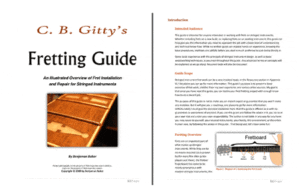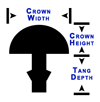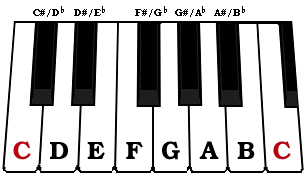 The questions come up often among Cigar Box Guitar builders: Is fretting worth it? Why would I want to fret my build? What do I need to know and what tools do I need to get started? Fretting can be a complex topic, but it doesn’t need to be a murky mystery to builders. This article will attempt to cover some of the basic concepts to help you decide whether you are ready to take the plunge, as well as point you to other resources to help you get started.
The questions come up often among Cigar Box Guitar builders: Is fretting worth it? Why would I want to fret my build? What do I need to know and what tools do I need to get started? Fretting can be a complex topic, but it doesn’t need to be a murky mystery to builders. This article will attempt to cover some of the basic concepts to help you decide whether you are ready to take the plunge, as well as point you to other resources to help you get started.
One of the best resources you can find to help you get started fretting is our C. B. Gitty’s Fretting Guide, a 39-page electronic book packed with photos and great do-it-yourself how-to information written specifically for the first-time fretter. The focus of this guide is how you can do good fret work using standard tools that you may already own, as opposed to the very pricey specialty tools available from suppliers like Stewart-MacDonald. If you want to help ensure that your first fret job is a successful one, you need this guide! We also offer combo deals of fret wire plus our guide on CD.
1. What is Fretting?
Fretting, also known as fretwork or fret installation, is the process of installing a series of raised stops on a stringed instrument neck, which allow the player to press the string down in different places to get different pitches. If you think of almost any standard acoustic or electric guitar, it is almost guaranteed to be fretted. The small metal wires that line the fret board (the wooden surface of the top of the neck) at regular intervals are the frets. As the instrument is played, these frets allow each string to create measured, exact tones at different places, which the player combines in certain melodically pleasing ways to create music.
 Over the years, a lot of different materials and methods have been used to fret instruments, from wrapping movable thread frets around the neck to wooden frets to metal bars. Modern frets however consist of a fairly standard shape: a (usually) rounded top portion called the crown, and a thinner flat barbed lower portion called the tang. The crown extends above the surface of the neck and is what the strings get pressed against. The tang is inserted into a pre-cut slot, and with its barbs helps hold the fret in place.
Over the years, a lot of different materials and methods have been used to fret instruments, from wrapping movable thread frets around the neck to wooden frets to metal bars. Modern frets however consist of a fairly standard shape: a (usually) rounded top portion called the crown, and a thinner flat barbed lower portion called the tang. The crown extends above the surface of the neck and is what the strings get pressed against. The tang is inserted into a pre-cut slot, and with its barbs helps hold the fret in place.
Fretting is, quite simply, the process of installing frets into the neck of a stringed instrument, in a consistent manner that allows for easy playing and good intonation.
2. Why Fret an Instrument?
There is no question that great instruments can be built without frets. The tradition of playing unfretted with a slide goes back a long, long ways, and is perfectly suited to Cigar Box Guitars. In fact, many of the early blues singers who built their own guitars out of cigar boxes and other materials played them with slides. There are many builders (and players) today who prefer the melodic freedom that comes with slide playing, and for good reason. If this style appeals to you, then by all means continue!
However, there are some points to be made for fretting your build. We will devote a bit of time to each of these related concepts below.
First, there is the concept of recognition. The 6-string guitar is one of, if not the most widely recognized and most popular stringed instrument in the world. Most people worldwide would immediately be able to recognize it at a glance. And the vast majority of the guitars manufactured in the last 75 years have been fretted. So when the public thinks about a guitar, they think about a fretted instrument. You need frets to play folk music chords, you need frets to flat-pick country music, you need frets to play classical style, and you need frets to play most heavy metal. Moreover, there are a LOT of guitar players out there, even if they only know a few chords.
So if your goal is to create an instrument that people recognize as a guitar, and that guitar players will be able to pick up and at least play a few basic chords, you pretty much need frets. Most standard guitar players would pick up an unfretted instrument and not really know what to do with it, unless they happen to have some background in slide playing, which is largely found amongst blues players.
 Second, there is the concept of standardization. Western music is based on a specific musical structure, made up of a scale of 12 semi-tones (known as the chromatic scale). Of these twelve semi-tones eight are called “whole tones” and these make up a standard octave – think of “do re mi fa so la ti do”, and you’ll have an idea of what this sounds like. This 12-tone scale is what forms the basis of most western music. Eastern and various forms of indigenous music have other structures, but the western style is our concern here. The modern guitar’s fretting is based on the 12 semi-tones of the western chromatic scale, and a precise mathematical formula (called the “rule of 18” or “12th root of 2”) is used to calculate where the frets should go to create the right pitches. It should be noted here that this concept also applies to instruments fretted diatonically, such as strum sticks and dulcimers. Those just leave out the “half tones” and only provide the whole tones – the “do re mi” of the scale.
Second, there is the concept of standardization. Western music is based on a specific musical structure, made up of a scale of 12 semi-tones (known as the chromatic scale). Of these twelve semi-tones eight are called “whole tones” and these make up a standard octave – think of “do re mi fa so la ti do”, and you’ll have an idea of what this sounds like. This 12-tone scale is what forms the basis of most western music. Eastern and various forms of indigenous music have other structures, but the western style is our concern here. The modern guitar’s fretting is based on the 12 semi-tones of the western chromatic scale, and a precise mathematical formula (called the “rule of 18” or “12th root of 2”) is used to calculate where the frets should go to create the right pitches. It should be noted here that this concept also applies to instruments fretted diatonically, such as strum sticks and dulcimers. Those just leave out the “half tones” and only provide the whole tones – the “do re mi” of the scale.
So a correctly fretted guitar (cigar box or otherwise) is part of a much larger standard. It is inherently suited to playing western-style music based on the 12-semitone chromatic scale. This standardization means that a person who “knows how to play guitar” should be able to pick up any guitar, be it an 6-string acoustic, a 12-string acoustic, an electric, a cigar box guitar, a 4-string tenor, or an electric bass, and expect to be able to play (with practice) what we in the west would call “standard” music (assuming it is tuned correctly). This might not be the case with other stringed instruments from around the world, such as some that are indigenous to far eastern and middle-eastern areas.
Finally, there is the concept of marketing appeal. This is built on the first two, and represents their real-world effect. If your Cigar Box Guitar looks like a guitar, sounds like a guitar and can be played like a guitar (at least as far as the fretting goes), then it will appeal to a wider audience of potential players. So if your goal is to sell your builds, this is important – your prospective customer base will be much wider if the neck is fretted and they can utilize their standard guitar skills on it. Of course this concept can vary depending on your audience – if you are at a conference for blues guitarists, then unfretted slide guitars will seem much less foreign. If you are at a county fair, on the other hand, the people looking at your guitars are much more likely to want to see a fretted neck.
3. What do I need to get started fretting?
Alright so you’ve waded through the theory and made it this far, and you’ve decided that you want to give it a go. The best advice we can give as far as what you need to get started is to invest in our C. B. Gitty’s Fretting Guide, mentioned above. This 39-page electronic book is written specifically for the first time fretter, with a focus on using standard tools to get the job done. In this article we will give a basic overview of what you need, but if you want the full story check out our guide!
- First you need something to fret. This can be a new cigar box guitar, an old standard guitar that you’ve removed the frets from, an unfretted factory-made guitar neck, or even a piece of hardwood you want to practice on. We always recommend practicing fretting on a hardwood stick (such as a poplar, maple or oak 1×2” board) before having a go at your special build.
- You will need some fret wire. We offer a wide range of different sizes and styles of fret wire in our online shop, at prices lower than you will find most anywhere else. For a standard guitar, you will need about four feet of fret wire. Requirements for Cigar Box Guitars vary based on neck width, but generally you can get at least two CBGs out of six feet (the quantity we sell most of our fret wire in), and possibly three. The best fret wire to start with for a CBG is Medium/Medium Nickel-Silver .
- You will need to know where to put the frets. This can be as easy as just copying an existing guitar neck using a straight-edge, or as complicated as figuring out locations using a mathematical formula. We go into depth on this process in our fretting guide, as proper placement of frets is critical to the overall playability and intonation of the instrument.
- You will need a few tools: a thin saw of some sort to cut the slots in the neck for the frets (see our fretting guide for a discussion of different saw and miter options); a small hammer to seat the frets into their slots; a pair of cutting pliers to cut the frets to length; and a file or files to smooth off the fret ends. There are many more advanced tools you can spend a lot of money on from suppliers like Stewart-MacDonald, but these are the basic tools you need.
In this article we have covered some of the basics of what fretting is and how it works, and we have discussed various reasons why you might want to do it. Finally, we gave a brief overview of what you will need to have on hand to begin your first fretting job. We hope you have found this information helpful, and wish you the best of success should you decide to give fretting a try. With the proper knowledge, patience and attention to detail, you CAN do good fret work and take your instruments to the next level.

The widest our largest miterbox will go is 2.5″. For any further questions or product support, e-mail us at [email protected]
Hello,
I have built dreadnought guitars as a hobby. Expensive hobby at that. The only two parts I buy prefabricated are the fretboard and bridge. I’m interested in cutting my own slots in my fretboards. Is the fretboard miter box wide enough to do a fret board for a dreadnought guitar fret board? I think it is, but I’m just making sure before I order. Also, is the miter box a duplication jig that duplicates from another slotted fretboard?
Thanks you,
Mark Miller
[email protected]
918-409-5463
There are many different factors as to why the frets may be popping out. Type of wood and kerf of the saw are chief among them.
Depending on how much wider the slot is, there is a tool to crimp the bottom of the frets to increase the surface area and get them to stick better that can help solve the problem if the slot is slightly overlarge. There is a tool made for this job, but you should be able to come up with a work around.
Alternately, luthiers have long used a drop of superglue to fix frets in that are slightly too loose. This will help the fret in place. using a small amount, just enough to secure it, will allow the fret to be pulled out later down the road, if it needs to be repaired or replaced.
my frets keep popping back out….why? I am using a stew mac fret saw with a depth guide cb gritty medium nickel wire.
Super simple explanation which gives me more tools in my knowledge box ! Thanks !